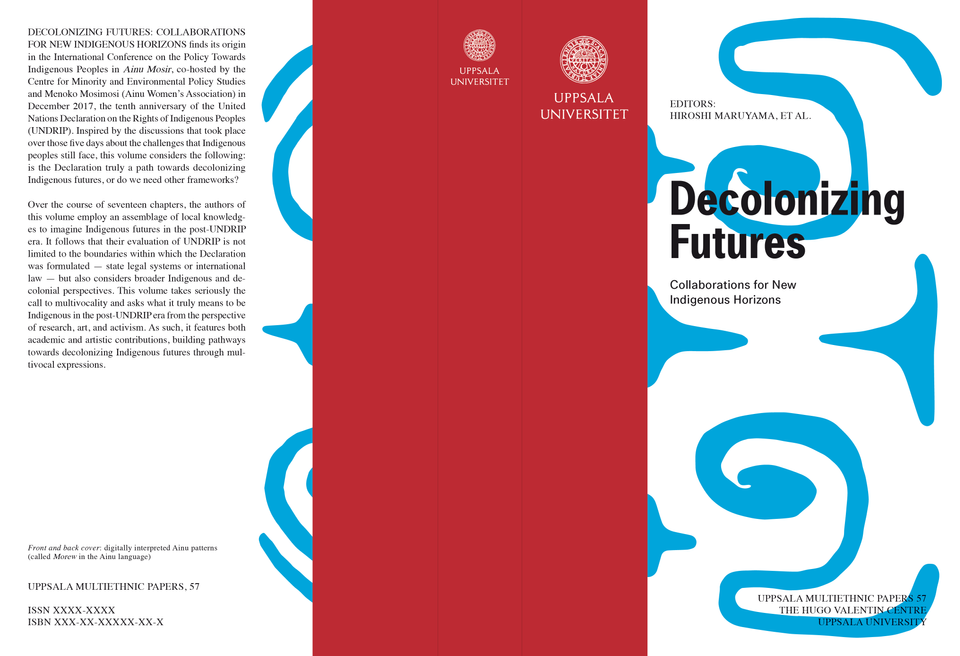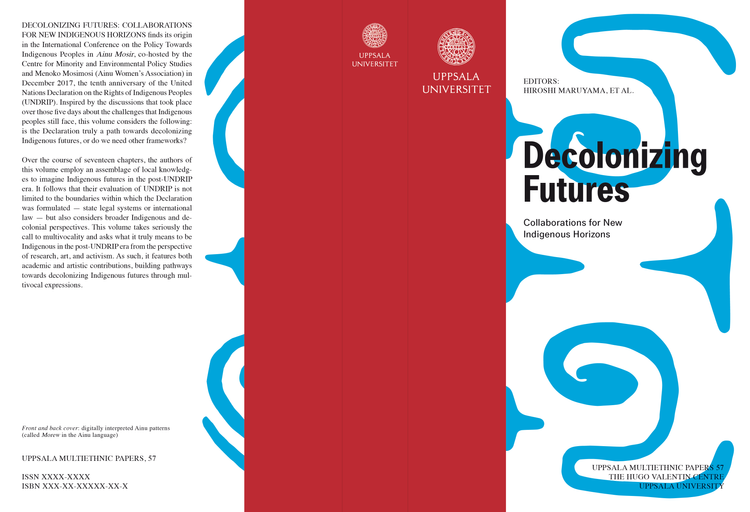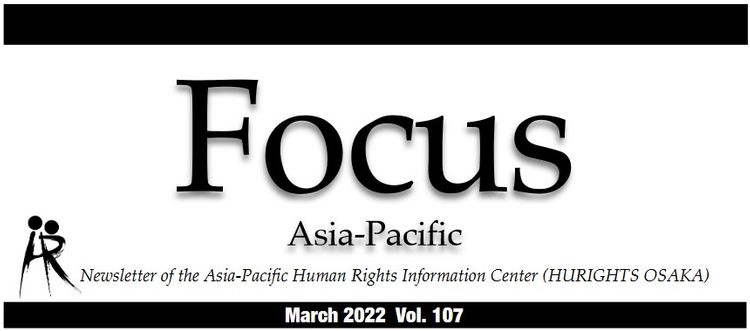Acknowledgements, Foreword, and Introduction of Upcoming Book "Decolonizing Futures"

As our collaborators at Uppsala University prepare our book Decolonizing Futures: Collaborations for New Indigenous Horizons for printing, we at CEMiPoS present its first few sections, introducing the origins of the work and its ambitions. The table of contents and introductions to the authors can be seen here, while a list of preliminary abstracts are available here.
Acknowledgements
by Hiroshi Maruyama
Our book is the fruit of a joint collective venture of Indigenous artists and researchers who have struggled against deep-rooted racism, colonialism, and sexism in the world through their art and research activities. The majority of the contributors participated in the “Indigenous Art Workshop and International Conference on Policy Towards Indigenous Peoples: Lessons to be Learned” held in Sapporo Japan from 30 November to 4 December in 2017. This art and academic event was hosted by the Centre for Environmental and Minority Policy Studies (CEMiPoS) and the Ainu Women’s Association (Menoko Mosmos in the Ainu language), with the support of the Hugo Valentin Centre at Uppsala University in Sweden and the Northern Institute of Environmental and Minority Law, Arctic Centre at the University of Lapland in Rovaniemi, Finland. In retrospect, the preliminary meeting about the art and academic conference just a week before the event in Sapporo with Leena Huss, Satu Gröndahl, Tomas Colbengtson and Kamrul Hossain at the Hugo Valentin Centre in Uppsala is a fond memory. They gave me confidence in myself. I express my gratitude to them as well as those organizations for their efforts to realize the art and academic event. In particular, Ainu women’s independent involvement in the event under the leadership of chairperson Ryoko Tahara made the event special and historical.
After the art and academic event, a number of collaborations between the participants have been carried out across the continents. From 2017 onwards, the Gdansk-based Amareya Theatre led by Katarzyna Pastuszak has produced and premiered performances with Ainu women from Menoko Mosmos in collaboration with CEMiPoS. In June 2018, Satu Gröndahl and Leena Huss invited Madoka Hammine to give a presentation at a seminar on language endangerment and revitalization at the Hugo Valentin Centre. In February 2019, Stockholm-based video artist/journalist Antonie Frank Grahamsdaughter began production of a documentary on legendary Ainu female artist/activist Shizue Ukaji, as the first volume in a series on Indigenous grandmothers in the world, also in collaboration with CEMiPoS. In October 2019, Leena Huss, Leni Charbonneau, and I were invited to the “Conference on the Strength from Within” at Dellie Maa (a Sami Indigenous Film and Art Festival) in Dearna/Tärnaby, Sweden, organized by Oskar Östergren Njajta and Marie Persson Njajta. These are part of the above-mentioned collaborations. The extension of these collaborations lies the publication of our book. In this context, the book is not only a collection of Indigenous artists’ materials and academic chapters but also that of collaborations for decolonization crossing the boundaries between art and research. Meanwhile, I became acquainted with three researchers such as Quintin Gumucio, Stefania Castelblanco Péres, and Carles Jornet Aguareles one after another. Unexpectedly, they accepted my sudden offer to contribute their chapters to our book. I deeply appreciate those who have collaborated ever since as well as those who added unique topics to the book.
It was not easy for us to edit and publish a book composed of eight Indigenous artists’ materials and seventeen academic chapters during the COVID-19 pandemic. Unsurprisingly, artists and researchers have had their own difficulties contributing to us. It was a pity that, in January 2020, James Daschuk had to withdraw his chapter from our book project due to his spouse’s health condition. Fortunately, by May 2021, there came a happy ending as he emailed me that his spouse had completely regained their strength. In August 2019, during our call for papers, Nina Sivertsen had just undergone an operation in the hospital. Contrary to our expectations, she submitted her chapter to us. Her incredible bravery inspired us to work hard on editing. June L. Lorenzo was frequently interrupted by COVID-19-related deaths of relatives and friends in the Navajo Nation and the Pueblo of Laguna. Nonetheless, she continued to work on her chapter throughout. Her struggle with adversity motivated us to finish strong. Furthermore, thanks to Elizabeth Sumida Huaman promising to contribute her chapter as soon as our book project was announced, and Fern Eyles and Jade Kake being the second to contribute before the first deadline, we could take one step forward. We also owed what we could take another step forward to Arnaq Grove taking more time than was expected of her to patiently improve her chapter. We are most grateful to all of the contributors for elaborating their work for our book in these uncertain and harsh times worldwide.
The editing process had two steps. First, from December 2019 to December 2020, Leni Charbonneau corresponded with contributors and their peer reviewers, proofread chapters, contacted Tomas Colbengtson about Indigenous artists’ materials, and arranged online editorial meetings. Meanwhile, Leena Huss, Satu Gröndahl, Kamrul Hossain, Janice Cindy Gaudet, and Maria de Lourdes Beldi de Alcantara warmly encouraged Leni to determine an editing policy and provided her with their expertise. Some of them reviewed chapters for us all. Meanwhile, Tomas Colbengtson kindly collected materials from Indigenous artists who had participated in the 2017 event in Sapporo. I feel a profound gratitude to them for laying the foundation for the publication of our book and for providing me with warm and moral support. Second, Mashiyat Zaman and Meindert Boersma from CEMiPoS spent half a year from January to June 2021 corresponding with all of the authors to edit the language and references of their chapters and prepare them for publication. In March 2021, Carles Jornet Aguareles joined CEMiPoS to help them edit the chapters, and to find and negotiate with a typesetter about producing a print-ready manuscript. Finally, Meindert and Leni worked together to compile the Indigenous artists’ materials with consent from Tomas Colbengtson. We are all indebted to the careful editing of our book provided by Leni, Mashiyat, Meindert, and Carles. I admire their insightful and careful editing, especially considering the tasks were new to them.
In addition, we are very thankful to Marcel Kaczmarek in Warsaw, Poland for producing beautiful book covers with Shizue Ukaji’s work, and Diego Muñoz, Barcelona, Catalonia for typesetting this volume. Throughout the editing process, Tomislav Dulić, Director at the Hugo Valentin Centre at Uppsala University generously provided us with detailed information about editing whenever we needed it. Lastly, I express my special thanks to the Indigenous artists such as Tomas Colbengtson, Louise Fontain Najavaraq, Antonie Frank Grahamsdaughter, Britta Marakatt Labba, Julie Edel Hardenberg, Elisabeth Haillman Blind, Torgeir Vassvik, Marie Persson Njajta and Shizue Ukaji, for making a big difference to our book with their beautiful art contributions.
This book is dedicated to the decolonization of policy towards Indigenous peoples and to all those individuals and communities who have struggled for it.
Hiroshi Maruyama
On behalf of other editors (Alphabetical order):
Carles Jornet Aguareles
Janice Cindy Gaudet
Kamrul Hossain
Leena Huss
Leni Charbonneau
Maria de Lourdes Beldi de Alcantara
Mashiyat Zaman
Meindert Boersma
Satu Gröndahl
Tomas Colbengtson
June 2021
Foreword: The Decolonization of Indigenous Ainu Women
by Ryoko Tahara (translated by Mashiyat Zaman)
In December 2017, researchers, artists, and representatives of Indigenous people from all over the world convened at Ainu Mosir for the International Conference on Policy Towards Indigenous Peoples and Indigenous Art Workshop & Exhibition. Throughout the event, participants discussed the history of injustice, ecological destruction, and colonialism that has sought to destroy the health, language, and culture of the Ainu people, as well as the compound discrimination that Indigenous women face. This gathering, in which we confronted our difficult history and considered how we can recover our human rights, was the culmination of what Hiroshi Maruyama and I had discussed more than two years prior. Thus, speaking as someone who has been involved since the beginning, there is no greater joy than seeing that our event was the beginning of the partnership that brought the authors of this book together.
Confronting both racism and sexism, Ainu women have long suffered the complex and multi-layered intersections of “compound discrimination”, in which various forms of discrimination are intertwined. Through the invasion and dispossession of Ainu lands, Ainu women faced contempt both as colonized subjects and as women, rendered as targets of sexual objectification. In school and at work, in marriage and beyond, Ainu women who were discriminated for their heritage resented being born Ainu at all, as they came to believe that such hardship and abuse were simply unavoidable. In the process of forming a new Ainu women’s group and studying our history, I discovered that the UN Committee on the Elimination of Racial Discrimination had used the language of intersectionality and compound discrimination to explain how racism disproportionately impacts women in different ways and on different levels than men, just as we Ainu women have experienced ourselves.
After that, members of the Ainu women’s group and I made it our goal to create an environment where we may not only bring light to the layers of harm that Ainu women face, but also discuss initiatives to improve the status quo and eliminate discrimination. Realizing the importance of creating a platform for our activism where we can share our traditions and knowledge more widely, we established Menoko Mosimosi, the Ainu Women’s Association, in April 2017.
While at first, we focused on our experiences with compound discrimination, after the Japanese branch of the Slow Food Association suggested that another way of recovering our agency is through food, we began to collaborate around Ainu food traditions as well. To date, through events such as the Ainu Food Festival, and the Indigenous Terra Madre and Pan-Pacific in Ainu Mosir, we have participated in activism promoting sustainable living through rethinking local traditional food culture.
In 2017’s Indigenous Art Workshop & Exhibition, the Polish contemporary theater troupe Amareya performed the modern dance Nomadic Woman, based on a true story of Greenland’s Inuit people. At the time, Menoko Mosimosi’s Tsugumi Matsudaira participated as well. In 2018 and 2019, commemorating the hundred-year anniversary of Japan and Poland’s diplomatic relationship, Amareya and the Ainu Women’s Association performed “a reenactment of the fateful encounter between a Polish cultural anthropologist and a Karafuto Ainu woman.” Karafuto Ainu descendant Kimiko Naragi and other Ainu women participated in this spectacular production that brought a full house in both its matinee and evening shows. I am proud that we were able to share this bridge between Japan and Poland with the world, and that the performance could become a source of empowerment for Ainu women.
In recent years, environmental destruction and climate change-induced natural disasters have taken the fortunes and lives of many. Amidst this suffering, COVID-19 rages, plunging the world into a state of fear and uncertainty as we are forced to watch loved ones stand on the brink of poverty or death. Whenever humans suffer such a calamity, we call it kamuy — in the Ainu language, we would call the novel coronavirus Payokakamuy, the god of illness. The Ainu have a saying, “Nothing falls from the sky without a destiny.” Humans cannot selfishly decide whether that which befalls them is a boon or a curse, as everything on this Earth carries a destiny. Thus, even as we wish for the pandemic to leave us in peace, we must think about its purpose, too. I believe the natural world is crying out in response to the environment’s continued destruction. Perhaps it’s saying, “Humans, please do not hurt this Earth any further!”
Indigenous people, each with their own language and culture, have long lived in this world in awe of and in coexistence with nature. Now, more than ever, humanity must seek knowledge of the natural world from Indigenous peoples in order to continue its existence on this planet. And as Indigenous people, in order for us to break free from colonization, we must not only increase our awareness of the hardships that we have suffered, but also gather the courage to confront discrimination, and organize our efforts sustainably.
In solidarity with the Indigenous peoples of this world.
Ryoko Tahara
Ainu Women’s Association Menoko Mosimosi
Introduction: Assembling the Multilocal, Multivocal Language for the Post-UNDRIP Era
by Leni Charbonneau
Nomadic
… with great Skilled in the other side of the life
so we find together, creating a sentence
a fragile community
— Everyone knows the same feeling of belonging to the periphery
— to be endured
language we find along the way...
—Navaraq, 2017
Language and place are two fundamental components to telling any story, to any history. Moreover, language and place inherently contain one another through a relationship of co-generation and co-dependency. Our languages are rooted in our places, and our places are born of narratives which have and continue to be articulated independently from fragile political demarcations.
The history of this book begins in December 2017, in Sapporo, on the island of Hokkaido in Japan — though already we find depiction both inadequate and inaccurate with regards to language and place. From its inception at the 2017 International Conference on the Policy Towards Indigenous Peoples (Centre for Minority and Environmental Policy Studies, n.d.), this story has always been multivocal. It was not only the common konnichiwa of Japan that foregrounded the opening words of the conference, but a mosaic of others… aluu! hello! hej igen! bures!... and, with a particular melodic force: irankarapte!
In our multivocality we both created and inhabited a space that was multilocal. We were not only in Japan but in Ainu Mosir, the homeland of the Ainu people Indigenous to the land graciously taking us in as guests. Although our venue was formed by the walls of Hokkaido University, the respective structures echoed the legacy of the institution’s colonial designers, many imported from Western nations in the early days of the modern Japanese state. This complex mosaic of multilocality was repeated in each punctuated moment of the 2017 International Conference on the Policy Towards Indigenous Peoples. As our gathering opened within a brick-laden lecture hall, the plainly-utilitarian seats were overtaken with colourful expressions of identity and place — a constellation of translocality. The diverse greetings and sentiments simultaneously projecting from the seats produced not cacophony, but a type of harmony only achievable through a certain level of incommensurability. Our symphony of difference found momentary steadiness when gazes collectively turned to an image projected over the classroom walls. An aerial photograph of a green, mountainous, and marshy land. Against the context of a white, cold-bitter day in urban Sapporo, one could intuit that this was a far-away place. A woman in front of the image spoke, telling us of this land called Sapmi in the northern throes of Europe. Yet as she spoke and wove her narrative — the opening remarks of what would become our collective narrative — the evocation of Sapmi was as close, visceral, and real as the tables and chairs in the room. Distance dissolved. Sapmi reassembled in that space, in Ainu Mosir and in Sapporo, alongside all of the other traces of places being carried into that lecture hall. This was truly an Indigenous space, wherein the localized and distant particularities of place merge with shared histories which have unfolded at a global scale. It was within this mantle of the multiple that Marie Persson Njajta — Sami activist, artist, and mother — spoke confidently that she finally had a context through which to tell her story.
Indigenous stories embody this type of unified multiplicity. The gathering in Sapporo was testament to the kind of places that we call Indigenous. Indigenous places are simultaneously local and have the capacity to make connections over wide distances. The fibers of these connections are woven through shared histories of place, which on the one hand is characterized by firm knowledge, respect, and love for land and heritage. On the other hand, the connective meshwork of Indigenous places is substantiated by shared experiences of colonialism and imperialism, whereby the very relationships between humans and place have been subject to disruption and attempts at erasure, concealment, denial, and distortion. The revolutionary nature of Indigenous places, then, is in their intrinsic ability to be rooted in what is local and familiar, and yet they subvert boundaries so often imposed on the local through transcendent connection and collaboration. Central, then, to the project of decolonization is this type of deterritorialization. The stories of Indigenous people and places therefore demand new conceptions of people and place. Accordingly, to write these new stories, to create new histories and futures, demands a new type of language.
So what is the language of this book? To speak of Indigenous places and people necessitates a type of expression that both listens to and respects the unique modalities produced of and within particular locales whilst always oriented towards a translocal collective effort. Our efforts are oriented towards an assessment of another artifact of language which has profoundly interfaced with Indigenous places and livelihoods. The 2017 conference which has incited this project was held on the tenth anniversary of the United Nations Declaration on the Rights of Indigenous Peoples (UNDRIP), and through our innovative language we have sought to inquire as to how and to what degree this seminal document has interacted with Indigenous futures and present realities. Although UNDRIP is presented here as the subject of our book, we must ask: does it truly speak the Indigenous language? Does it represent the language of decolonization?
In a sense, we aim to speak as an assemblage, in the terms of a dynamic and symbiotic community that is always reconfiguring and contesting boundaries (Deleuze and Guattari 1987). It follows that our evaluation of UNDRIP is not limited to the boundaries within which the Declaration was formulated — state legal systems or international law — although those are included in our collective assessment. In the present volume, we take seriously the call to multivocality to ask what it truly means to be Indigenous in the post-UNDRIP era. As such, a wide array of expressions is represented on these pages, corresponding to equally diverse places. In so doing, we echo the founding intention of the 2017 International Conference on the Policy Towards Indigenous Peoples, which was to create a space in which academics, artists, and activists speak and inquire together. Just as Indigeneity speaks to that which is translocal and multivocal, this current volume presents a unison of voices which, to different extents, may be recognized as political, academic, research-oriented, pedagogical, epistemological, narrative, and historical. Furthermore, this volume has additional dimension through exposition of visual pieces by Indigenous artists from around the world, first showcased at the 2017 gathering in Sapporo. The artistic pieces and profiles interspersed throughout this volume mark a preliminary unbinding of the themes concerning identity, place, and experience — far too often relegated to text alone. The images, poems, and stories should thereby not be encountered as mere supplements to the text, but as integral features of our collaborative, multimodal, and ever-expanding grammar.
Although this volume has been produced in the spirit of transcending boundaries and categorizations, we have identified four loose and inherently intertwined areas through which we have considered the state of Indigeneity in the post-UNDRIP era. The first section of this book employs historical analytical frameworks through which our contributing authors have considered the particular types of injustices which characterize shared histories of colonialism, imperialism, and persistent forms of inequality. The second section turns to that which is universally particular for every strand of Indigenous politics — land. As Sámi activist, artist, and mother Marie Persson Njajta reminded us in Sapporo in 2017, it is the land and waters which carry our stories. To compromise the land is to compromise the very being of Indigenous peoples and indeed all peoples everywhere. Accordingly, the section of this book devoted to land has a wide swathe of considerations, from resource rights and struggles against corporatism, to spirituality, to psychological and physiological health. The third section of this volume is devoted to a struggle often nested — and far too often concealed — in the wider topics of Indigenous politics: gender equality. As our writers in this section highlight, women have foregrounded key institutions of care and social stability in many Indigenous societies, and histories of colonial domination have severed these crucial institutions rendering Indigenous women particularly vulnerable to exploitative practices. Finally, a fourth section brings together injustices of the past with future-oriented strategies for Indigenous survival. Our contributors here speak to the imperative role of Indigenous education and linguistic revival towards more just and sustainable futures.
Although this project and its inciting event — the 2017 conference — has been supported by the Centre for Environmental and Minority Policy Studies (based in Japan), the connections herein would not have been possible without the gracious welcome to Ainu Mosir by the activists, leaders, and thinkers behind the Ainu Women’s Association. The voices of this project harmonize many central elements, but perhaps foremost is the recognition that decolonization for any population begins with the correction of exploitation on any level of society. The voices included in our histories reveal the types of futures we might anticipate, and, to be realized meaningfully, decolonization must imply the amplification of voices which domineering historical forces have sought to dislocate. From this we uncover the central objective of the book: that it is ultimately through collaboration that we can reassemble political horizons, and challenge hegemonic practices of territorialization — of both place and identity — which have subordinated landscapes of cultural difference. Decolonization becomes possible once we re-territorialize the horizons of political possibility, ultimately rendering symphonies of difference.
References
Centre for Environmental and Minority Policy Studies. n.d. “International Conference on Policy Towards Indigenous Peoples 2017.” Accessed 8 June 2021. https://cemipos.org/international-conference/.
Deleuze, Gilles, and Félix Guattari. 1987. A Thousand Plateaus: Capitalism and Schizophrenia. Translated by Brian Massumi. Minneapolis, MN: University of Minnesota Press.
Ueno Chizuko. 1996. Sabetsu to kyōsei no shakaigaku [The sociology of discrimination and coexistence]. Tokyo: Iwanami Shoten.




